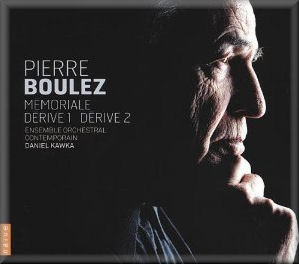 |
 |
|


alternatively
CD: AmazonUK
AmazonUS
Sound
Samples & Downloads |
Pierre BOULEZ (b.1925)
Mémoriale for solo flute and eight instruments (cello,
horn, viola, three violins) (1985) [5.39];
Dérive 1 for cello, clarinet, flute, piano, vibraphone,
violin (1984) [6.26];
Dérive 2 for bassoon, cello, clarinet, English horn, harp,
horn, marimba, piano, vibraphone, viola, violin (1988, rev. 2001/2006)
[50.40]
 Fabrice Jünger (flute)
Fabrice Jünger (flute)
Ensemble Orchestral Contemporain (Guillaume Lafeuille (cello); Didier
Muhleisen, Thierry Gaillard (horn); Brice Duval, Patrick Oriol,
Gaël Rassaert, Mathieu Roussel, Nicolas Miribel (violin); Hervé
Cligniez (clarinet); Roland Meillier (piano); Claudio Bettinelli
(vibraphone); Laurent Apruzzese (bassoon); François Salès (English
horn); Emmanuelle Jolly (harp); Roméo Monteiro (marimba))/Daniel
Kawka
rec. Salle Guy Porieux, Montbrison, France, June 2011
 NAÏVE MO 782183 [63.10]
NAÏVE MO 782183 [63.10]
|
|
|
It seems that you either love him or hate him; not, that is,
Boulez the musician and conductor but Boulez the composer. Much
of that goes back to the days when he condemned opera houses
to hell-fire and the symphony to the department of hopeless
causes. Now, at 87, he is the grand old statesman of modern
music and needs to be taken very seriously.
If you listen with an open mind to his work you encounter a
sensitive and meticulous ear for sonority and line which has,
all too often, been overlooked. For instance, right from the
start of Mémorial the flute winds itself around
a dancing line often ending with a trill the pitch of which
is then captured and elongated by one of the two horns. This
is a chamber work for alto flute, two horns, three violins,
two violas and cello. It is fleeting, scintillating and crepuscular
and is a memorial to a young flautist Lawrence Beauregard who
died in 1985 aged 31. He had been involved just previously with
IRCAM in Paris, founded by Boulez and with Boulez’s ‘Explosante-fixe’
which itself was a memorial to Stravinsky. The structure of
the work was based on Stravinsky’s Symphonies of Wind Instruments,
itself in memory of Debussy. It is in several sections configured
in a way sometimes called ‘chain-form’. Boulez’s Mémoriale
flows continuously with no sense of break or change of texture.
Perhaps it’s just a chip from the workshop, and you may say
the same about Dérives 1 written the year before.
The scoring is similar to that of Schoenberg’s Pierrot Lunaire
that is flute, clarinet, piano, violin and cello but with the
magical inclusion of a vibraphone. The title derives from several
sources: first, one element is sparked into life (derived from)
a previous fragment, secondly from a series of six notes which
use the name of Paul Sacher the celebrated conductor and patron
of music and thirdly some of the material comes from a recently
completed work of great importance in Boulez’s output: ‘Répons’.
Having said all that, just enjoy the wash and gorgeous sounds,
the trills and swirls that build to the central climax, drop
away and build again creating an image of quivering fantasy.
Dérives 2, scored for a small orchestra of eleven
players, began as an 80th birthday present for Elliott Carter,
but as is typical of Boulez the work constantly evolved in versions
up to 2001, and finally in 2006 when, at last, Carter could
hear his present. The derivations are fragments of pieces by
Ligeti and Carter. Robert Piencikowski in his wordy but generally
useful liner-notes, fails to tell us which, but Boulez uses
these ideas isorythmically as a 14th Century composer
might, even employing hoquets. It is quite extraordinary how
Boulez spins his ideas out into a fifty minute duration and
just as remarkable is the evident concentration brilliantly
brought to bear. It is a coruscating score with moments of greater
stillness. A more static sound - as for example at about eleven
minutes in – provides what are called in the booklet “successive
interruptions”. Gradually they become a more prominent aspect
of the entire work. Sometimes a chord is sustained with isolated
pockets of activity above it, before moving on again. There
are occasional passages when a soloist is highlighted surrounded
by a halo of polyphony. The clarinet, oboe and bassoon are especially
noticeable in this connection. The ensemble is grouped as two
trios - one of woodwind and one of strings, two duos - one of
percussion and one including the harp and piano. They form an
axis around the solo horn which starts the work on A sharp.
The final pages build dramatically and excitingly towards the
concluding reiteration of a G sharp. This is repeated aggressively
rather as Sibelius did at the end of the Fifth Symphony. The
whole work, apart from these occasional still moments, is breathless
and totally energising. I have in my listening life, as I am
sure have many of you, spent fifty minutes in the presence of
music which should not have lasted half that length. With this
work I was never uninterested or bored. My attention was maintained
and I was also emotionally engaged in its sound-world.
As well the essay mentioned above there are performer photographs.
Daniel Kawka writes a few words about his association with Boulez.
He has a very wide repertoire but with particular emphasis on
French music. He must rank as one of the top conductors and
indeed musicians of our time, although as yet, not so well known
in the UK as he is on the Continent.
The performances on this CD are beyond reproach. The recording
is clear and detailed. This is great music but undoubtedly challenging.
It is, however, important and of lasting value.
Gary Higginson
|
|

